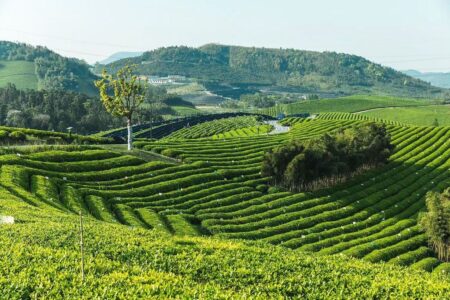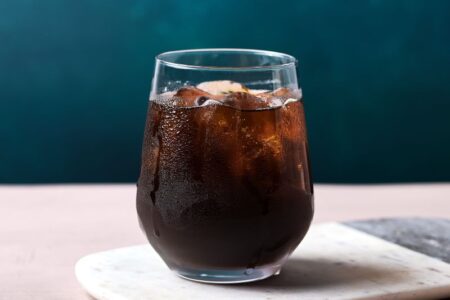Competition Stiffens in China’s RTD Coffee Market

Mass-market RTD coffee in a supermarket in Shanghai.
Ready-to-drink coffee sales are surging in China because of the country’s increasingly sophisticated coffee culture.
Article by Wang Fangqing.
All images courtesy of Wang Fangqing.
The growing variety of ready-to-drink (RTD), capsule and home-brewing ground coffee products being made available in China is a testimony to how this market has matured since Nestlé started pushing instant coffee on consumers beginning in 1990.
Global market research firm Euromonitor International estimates that China’s RTD coffee market size is burgeoning, predicting it will grow 32.9 percent to Chinese Yuan Renminbi CNY10.9 billion (USD $1.54 billion) in 2023, up from CNY8.2 billion in 2018.
It is impressive growth and reflects how consumers in this traditionally tea-focused country continue to explore different ways to drink coffee. Euromonitor estimates that retail sales for fresh coffee and instant coffee in China will reach CNY7.96 billion (USD $1.12 billion) in 2023, up 9.7 percent from CNY7.25 billion (USD $1.16 billion) in 2018. This steady growth hides an important message, however, that sales of fresh coffee to more sophisticated coffee drinkers are really booming – sales of products including whole beans, ground coffee and capsules are projected by Euromonitor to jump 82 percent from 2018 to 2023, (instant coffee sales will grow only 5.4 percent over the same time period).

Nestlé Cold Brew, launched in November 2018.
This explains why an alliance forged between Starbucks and Nestlé in 2018, is now promoting ‘Starbucks at Home’ in China. The collection of 21 products includes Starbucks ground packaged coffee, beans and capsules using Nestlé’s Nespresso and Dolce Gusto systems.
The products are currently available online via Starbucks at Home e-stores on Chinese major B2C websites, including Tmall, JD.com and Suning, and will also be sold in the future at an increasing number of high-end hotels and retail stores in major metropolitan areas, such as Shanghai and Beijing.
At a launch party held in Shanghai on 8 August, attended by Tea & Coffee Trade Journal, Nestlé China CEO Rashid Aleem Qureshi said the partnership unlocks exciting opportunities in China, today the second largest market for Nestlé and Starbucks.
Belinda Wong, Starbucks China CEO, added that the market size and potential for the overall coffee market in China are enormous. “Our alliance with Nestlé is only the beginning. Together we will continue to expand our reach to more Chinese consumers thanks to the evolving lifestyle in the country,” she said.
Innovation Fuels RTD Growth
Fast-expanding coffee chains, such as Starbucks, are fuelling China’s demand for sophisticated coffee choices, from RTD to coffee service retail said Altug Guven, Nestlé China svp for the coffee business. “A cup of high-quality fresh coffee is affordable and easy to grab thanks to nationwide expansion of these shops,” he told T&CTJ at the launch party.
Such market maturity is helping increase competition in the RTD sector, which is characterised by frequent new product launches. In May, the major Chinese mineral water manufacturer Nongfu Spring launched a carbonated RTD coffee priced at CNY5.90 ($0.83) per bottle (360ml). In July, The Coca-Cola Company launched a similar product – soda with extract of Brazilian coffee – priced around CNY4.90 ($0.69) per bottle (330ml). Nestlé dominates the Chinese RTD coffee market by enjoying 60.9 percent market share in 2018, followed by Japan’s Suntory 8.4 percent and Kirin 4 percent, according to Euromonitor.
A 2018 report from Mintel Group Ltd, another global market researcher, pointed out that RTD coffee has gained a lot of popularity among young Chinese consumers possibly because of such flavour innovations by big brands. Regionally, it continued, low/no/reduced sugar RTD coffee is most sought by female consumers in Beijing, while in general, Chinese female consumers are willing to pay a little extra for better ingredients such as claimed organic ingredients.
In general, “latte is the most-seen flavour in China’s RTD coffee market,” said Euromonitor analyst Mark Miao, who noted that this “leaves opportunities for novel new flavour launches.”
Seattle, Washington-based Starbucks Coffee has also been listening. In June, it introduced Doubleshot Energy, an RTD product, in China. Priced at CNY18 (USD $2.54) per bottle (270ml), the range includes Ice Americano and Power Latte variants. In a statement, Starbucks said the line has been developed by its China-based team for the Chinese market to attract younger consumers seeking instant energy boosts to face challenges in daily life. Doubleshot Energy was launched exactly a year after the company’s launch of the Doubleshot brand in China.

Sparkling coffee from Nongfu Spring in a supermarket in
Shanghai.
In November 2018, Nestlé launched Cold Brew coffee in three flavours: Americano, Latte and Mocha, priced around CNY13 ($1.84) per bottle (280ml). Per a Nestlé statement, Cold Brew targets young Chinese who seek high quality RTD coffee. Nestlé said it had received positive feedback on both taste and package design.
Outlining its multi-pronged strategy to develop coffee sales in China, the Vevey, Switzerland-based CPG company added, “We believe there will be more consumers in China looking for premium RTD coffee experience. At Nestlé, our focus is to further popularise coffee culture and increase the penetration of coffee in the Chinese market.”
RTD Faces Competition from Fresh
Euromonitor’s Miao thinks fresh coffee will be a key focus of this growth, with more Chinese consumers seeking better coffee experience, which means freshness and taste. And alongside its Starbucks at Home initiative, Nestlé opened a Tmall store in May (2018) to sell Chinese consumers Nestlé Japan’s products, including drip-style coffee and ground coffee.
Drip-style coffee is a growing niche in China, with more consumers enjoying it around lunch time and on weekend mornings, per Mintel. But concerns over drip bag material safety and a lack of customer knowledge on how to prepare and serve such coffee are restricting growth, according to Mintel, “We suggest players pay more attention to market education and filter materials,” said its report.
Price is another deterrent. For many Chinese consumers, Starbucks’ prices – at about CNY30 ($4.27) per cup – is expensive. But there are cost effective options, including Starbucks’ China rival Luckin, which offers price points ranging from CNY21 ($2.97) to CNY27 ($3.28), fast food giants KFC and McDonald’s, as well as convenience stores such as FamilyMart, that offer fresh coffee around CNY15 ($2.12) per cup.

Starbucks’ RTD Doubleshot Energy, launched in June.
The prominence of such chains is important for bringing new Chinese consumers to the widening coffee market, including RTD, helping them learn about beans and quality, stated Mintel. “Advertising by these chains tend to pitch hard about the chosen beans, which usually are from well-known coffee regions,” said its 2018 report.
Starbucks at Home products tap into this growing sophistication, with packs emphasising how the contents include selected Arabica beans, meeting Starbucks’ standards.
Will China’s weakening economic growth, buffeted by growing costs and the trade war with the United States, stymie the expansion of coffee sales in China? Not a chance, said Nestlé’s Guven, “As far as we see, Nestlé’s coffee business in China is going forward very strongly,” he said.
- Wang Fangqing, also known as Frances Wang, is an experienced freelance reporter based in Shanghai. She has written about business issues in China, spanning a wide range of sectors, for more than 10 years. Her work has appeared in a range of specialist business journals.



